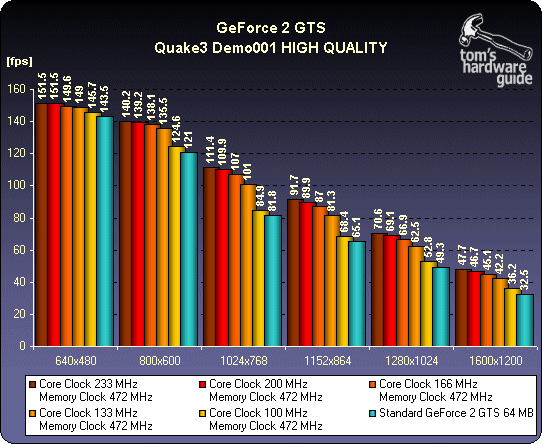ATi's New Radeon - Smart Technology Meets Brute Force
Fill Rate And Memory Bandwidth - They Belong Together! Continued

Things are even worse in 32-bit color. Even the Gainward card is dropping its frame rates, proving that it is under memory bandwidth restriction. However, the standard GeForce2 GTS card is not even able to reach the scores of the Gainward card underclocked to a pathetic 100 MHz core clock!! This simply shows that the GeForce2 GTS chip equipped with standard memory is not even able to supply 400 Mpixel/s at 32-bit color. In fact it is even less than 300 Mpixel/s, as I will show you in my upcoming article.
Before now the 3dfx-freaks start shouting hurray, because I found a speckle on NVIDIA's vest, I would like to remind all Voodoo5 owners of the fact that the good Voodoo5 5500 scores even less than GeForce2 GTS, although 3dfx had the courage to claim that Voodoo5 5500 had a fill rate of 667 Mpixel/s. The new 3dfx card is even less able to live up to those claims, once again because of its memory restriction. This is even more disappointing than GeForce2, because Voodoo5 5500 has got the very same memory bandwidth as GeForce2. If it had the claimed fill rate it would kick GeForce2's butt. However, its 16-bit fill rate is closer to 500 Mpixel/s and its 32-bit fill rate just above 200 Mpixel/s. Ain't that sad?
I hope that this will make you understand why Radeon with its pathetically sounding fill rate of only 366 Mpixel/s is able to be right up there with the competition. By using its memory more efficiently than the others Radeon can deliver where the others can't.
Summary HyperZ
The memory bandwidth has become the most important factor for high-end 3D chips today, which is well known to the entire 3D-chip industry, but nobody would talk about it. We have just learned that even chips with the highest theoretical fill rate can't deliver due to memory restrictions, so that claims of fill rates above 600 Mpixel/s can only be sustained with either a memory bandwidth way above 5.3 GB/s or a new technology that avoids unnecessary accesses to memory.
HyperZ improves frame rates by about 20% right now and it will probably be even more soon, once all the features have the proper driver support. HyperZ reduces memory bandwidth requirements at the same time as it limits the waste of fill rate for pixels that are not supposed to be displayed. With memory advancing much slower than 3D chip performance ATi has done the right thing. If the memory doesn't get faster soon enough the solution is to use its bandwidth more economically. Radeon is the first 3D chip of the year 2000 that can actually live up to its (admittedly modest) fill rate claims.
Stay on the Cutting Edge
Join the experts who read Tom's Hardware for the inside track on enthusiast PC tech news — and have for over 25 years. We'll send breaking news and in-depth reviews of CPUs, GPUs, AI, maker hardware and more straight to your inbox.
Current page: Fill Rate And Memory Bandwidth - They Belong Together! Continued
Prev Page Fill Rate And Memory Bandwidth - They Belong Together! Next Page C - The Pixel Tapestry ArchitectureMost Popular

